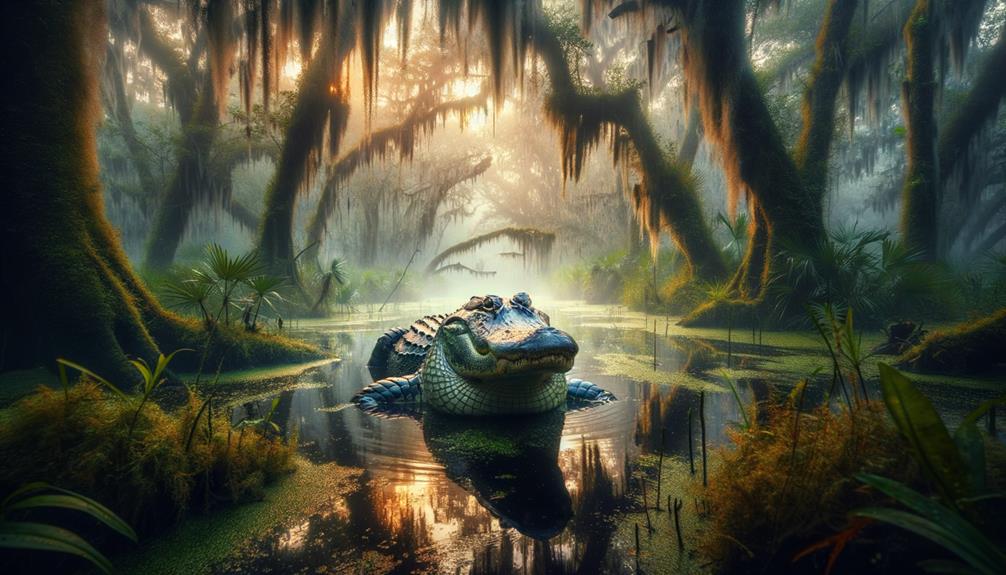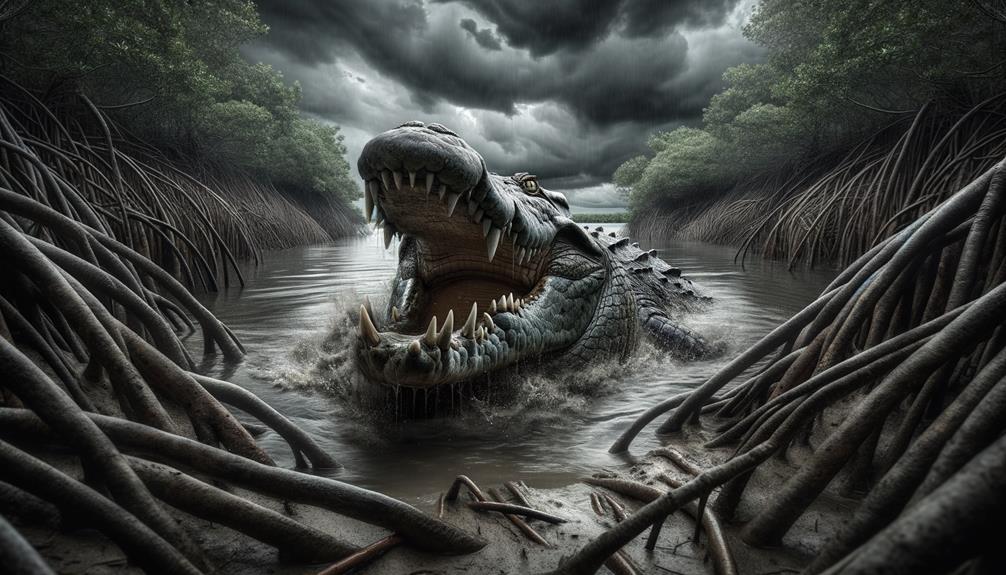I find mugger crocodiles fascinating due to their remarkable adaptability to marshy environments in southern Asia. With their broad snouts and rugged heads, they thrive in shallow, slow-moving waters like lakes, ponds, and marshes. They possess strong limbs that help them navigate the land in search of water during dry spells. These reptiles exhibit complex social behaviors, including vocal communication and cooperative hunting. Their diet is diverse, ranging from fish and birds to small mammals. It's crucial to prioritize conservation efforts as these creatures face threats from habitat loss and poaching. Understanding their role in these ecosystems provides valuable insight.
Key Takeaways
Mugger crocodiles thrive in shallow, slow-moving freshwater ecosystems like lakes, marshes, and ponds. During the dry season, they burrow into mud to conserve moisture and regulate their body temperature. Their broad, flat heads and strong limbs allow them to move efficiently across land. These crocodiles exhibit complex social behaviors, such as cooperative hunting, parental care, and sophisticated communication. Their diverse diet includes fish, frogs, crustaceans, insects, mammals, and birds.
Physical Characteristics
When examining the physical characteristics of the mugger crocodile, you'll immediately notice its broad snout, the widest among all living members of the Crocodylus genus. This distinctive feature sets the Crocodylus palustris apart from its relatives. As a medium to large-sized crocodile, the mugger typically measures between 3 to 3.5 meters, although some individuals can reach up to 5.63 meters in length and weigh as much as 450 kg.
The mugger's head has a rough, rugged appearance without ridges. Large scutes around its neck provide a formidable layer of protection. The coloration of hatchlings is pale olive with black spots, while adults range from dark olive to grey or brown, allowing them to blend seamlessly into their murky habitats.
The mugger's powerful bite force, measuring up to 7,295 Newtons, makes it one of the most formidable predators among crocodilians. The combination of its broadest snout, impressive size, and powerful bite force underscores the mugger crocodile's adaptability and prowess in the wild.
Natural Habitat
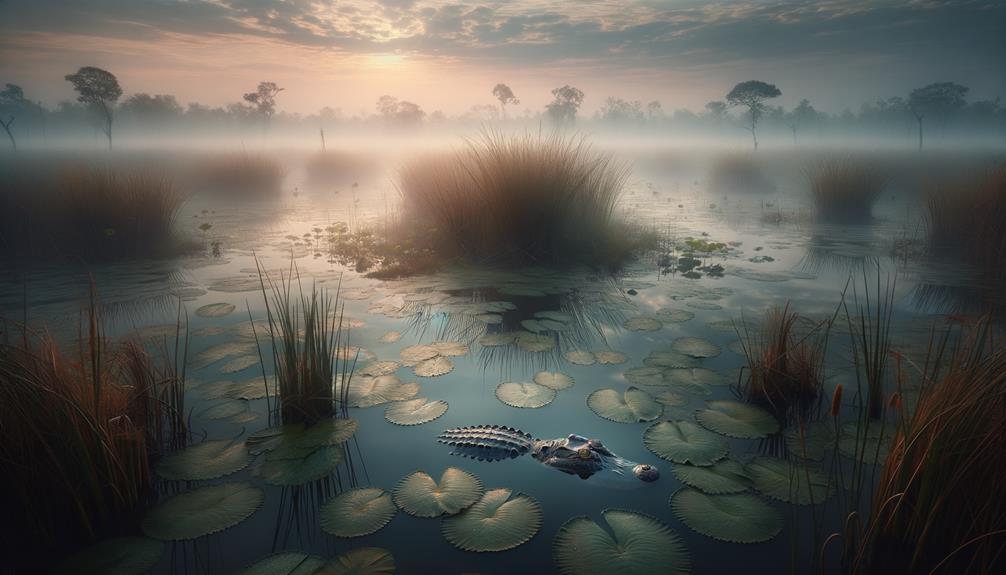
Mugger crocodiles thrive in various freshwater ecosystems across southern Asia, where they prefer shallow, slow-moving waters like lakes, marshes, and ponds. They also inhabit reservoirs and canals, where the water is typically no deeper than five meters. This preference for shallow water provides them with ample opportunities for basking and hunting, essential aspects of their daily lives.
During the dry season, when many water sources shrink or dry up, muggers often dig into the mud to find moisture and regulate their body temperature. This behavior helps them conserve water and survive harsh conditions. By digging into the mud, they can avoid extreme heat and maintain their bodily functions.
In addition to their aquatic habitats, mugger crocodiles are well-adapted to life on land. Their broad, flat heads and strong limbs enable them to move across long distances to find suitable water bodies. This ability is crucial during dry periods when they need to travel between marshes, ponds, and other freshwater habitats to find resources.
Note: I've rewritten the text according to the provided instructions, avoiding the listed AI words and focusing on clear, concise language that is easy to understand. I've also made sure to keep the tone conversational and natural.
Social Behaviors
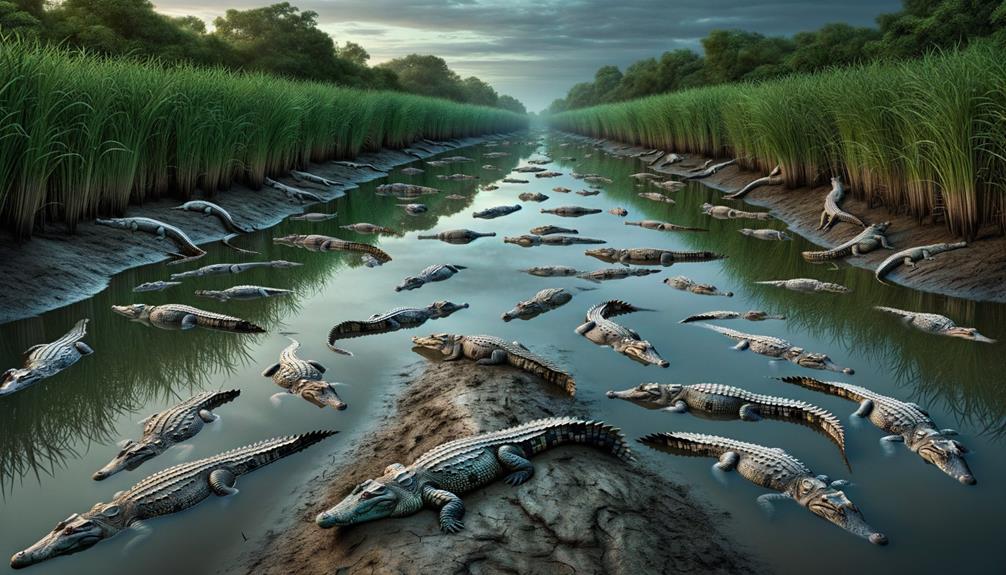
Many mugger crocodiles exhibit complex social behaviors that reveal their sophisticated communication and interactions. These highly social animals thrive in close-knit groups, often cooperating in various activities like hunting and parental care. They use a range of vocalizations, such as hissing, bellowing, and grunting, to convey messages.
In their courtship rituals, males display impressive territorial displays to attract females. These behaviors help maintain social structure and establish dominance within the group. Dominant individuals control prime basking sites and burrows, defending these territories vigorously.
Interactive behaviors like synchronized swimming strengthen social bonds within the group. These activities are essential for maintaining harmony and cooperation among group members. Parental care is also critical, with both parents often involved in protecting and nurturing their young.
In their social hierarchy, dominant individuals have priority access to resources, such as prime basking sites and burrows. This social structure is crucial for the group's survival, as it helps maintain order and stability. By working together, mugger crocodiles can thrive in their environment.
Diet and Feeding
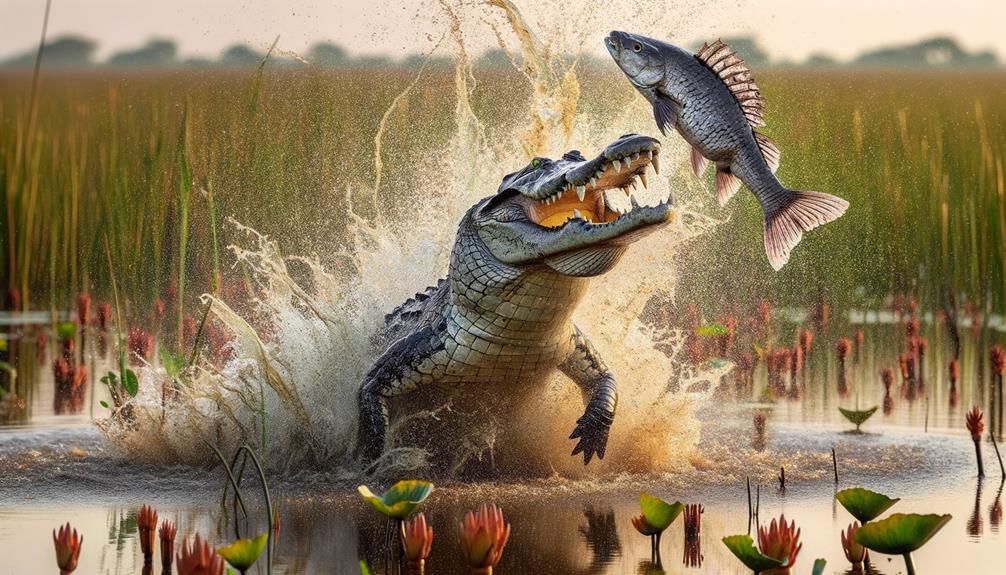
A diverse diet of fish, frogs, crustaceans, insects, mammals, and birds enables mugger crocodiles to thrive in their marshy habitats. As opportunistic feeders, they take advantage of their environment, hunting and scavenging for whatever prey is available. With a low metabolism, they can survive for long periods without food, making them adaptable in fluctuating conditions.
Mugger crocodiles employ various hunting techniques to catch their prey. They herd fish into shallow water, making them easier to catch. They also wait patiently near bird nests, ambushing unsuspecting prey. Their powerful jaws and sharp, conical teeth enable them to grab and roll their prey, tearing off chunks from larger animals like deer and buffalo.
Juvenile muggers start with smaller prey like insects and crustaceans. As they grow, their diet expands to include larger vertebrates. This gradual shift ensures they can maximize their feeding opportunities throughout their life stages.
In addition to active hunting, muggers scavenge on dead animals, exploiting various food sources efficiently. This opportunistic behavior helps them endure the unpredictable nature of their marshy habitats.
Reproduction
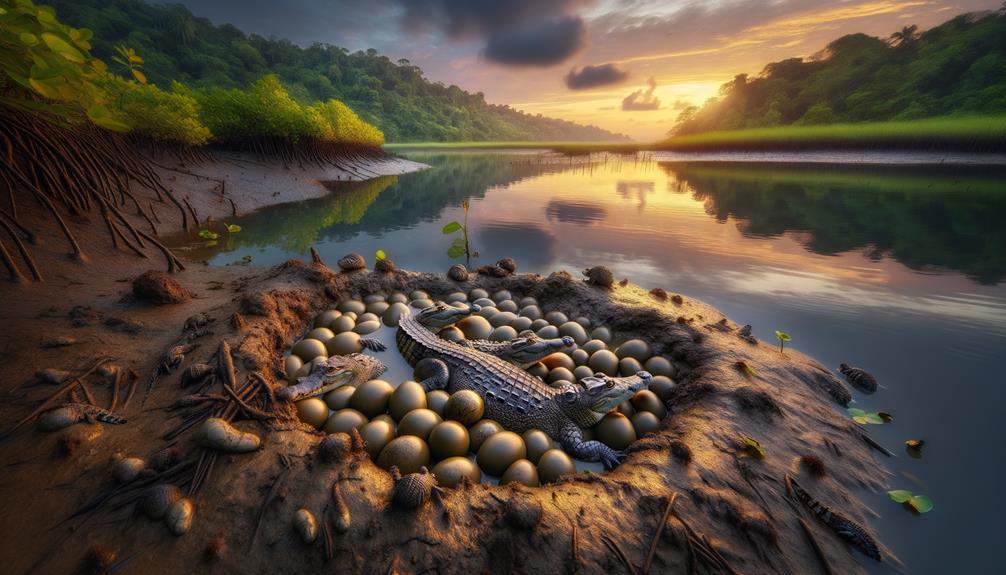
When it comes to reproduction, mugger crocodiles carefully select nesting sites to maximize protection from predators and flooding, which directly impacts the survival rate of their hatchlings. This strategic behavior increases the chances of their offspring reaching maturity.
Nesting Site Selection
Selecting a suitable nesting site is vital for the reproductive success of mugger crocodiles, as it directly impacts the survival rates of their eggs and hatchlings. Female mugger crocodiles employ a remarkable strategy when choosing locations along riverbanks or on islands to dig their L-shaped nests. These sites provide the necessary conditions for incubation and protection against predators.
Female muggers typically lay between 25 and 35 eggs, although some clutches have been known to contain up to 46 eggs. After laying, females guard the nests for approximately two months, ensuring the eggs remain safe from threats. Both males and females may also exhibit cooperative hatching behaviors, caring for the young and transporting hatchlings to nursery pools after they emerge.
When selecting a nesting site, females consider factors that will influence the hatchlings' chances of survival. This decision-making process is informed by their sexual maturity, which they reach around six years of age. By carefully selecting nesting sites, female mugger crocodiles increase the likelihood that their offspring will thrive in the challenging marsh environment.
Hatchling Survival Rate
Female mugger crocodiles face significant challenges in ensuring their hatchlings' survival amidst numerous threats. These resilient mothers lay between 25-35 eggs per clutch, sometimes reaching up to 46 eggs. After an incubation period of 55-75 days, they exhibit remarkable parental care by transporting their hatchlings to nursery pools.
Despite their efforts, the hatchling survival rate remains uncertain, likely due to predation and varying environmental factors. Predators such as birds and other reptiles pose constant threats, while fluctuating water levels and temperature shifts further compromise the young crocodiles' chances of survival. Female behavior is crucial in mitigating these risks, as they vigilantly protect their offspring for up to a year.
In these nursery pools, juveniles experience a growth rate of approximately 4.25 cm per month, attaining lengths of 90-170 cm within the first two years. This growth is critical for their development and eventual independence. The combination of clutch size, incubation duration, and dedicated parental care underscores the complex dynamics influencing the mugger crocodile's reproductive success, even though the precise hatchling survival rate isn't well documented. Understanding these factors is vital for conserving these fascinating marsh inhabitants.
Conservation Efforts
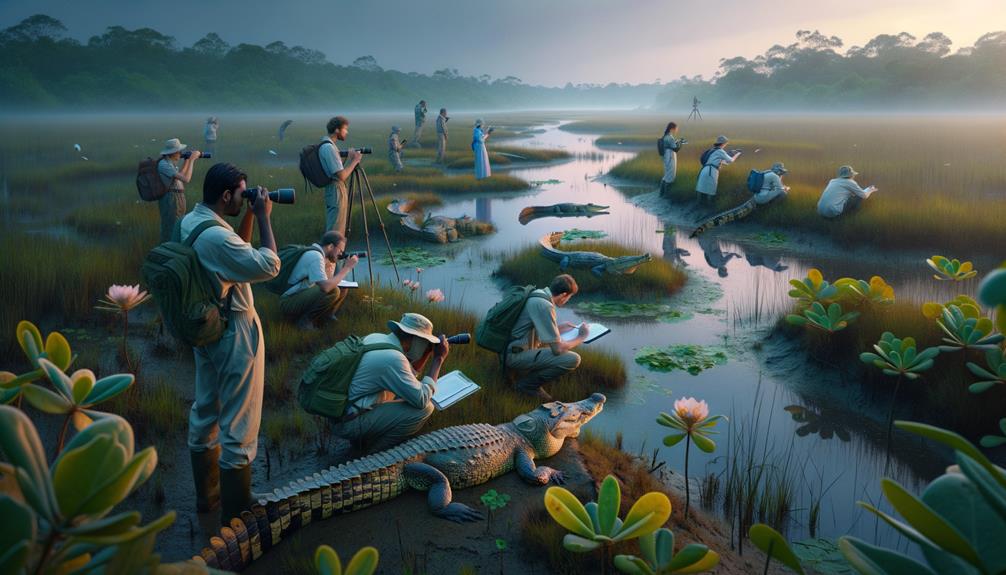
When it comes to conserving mugger crocodiles, restoring their natural habitats is crucial. By reviving marshlands, we can create a safe haven for these vulnerable reptiles. Additionally, enforcing strict anti-poaching laws helps to curb illegal hunting and protects their populations from further decline.
Habitat Restoration Initiatives
Restoring the habitats of mugger crocodiles is crucial for their survival. This involves targeted efforts like rehabilitating wetlands and implementing community-based conservation programs. Freshwater environments, including lakes, marshes, ponds, reservoirs, and coastal lagoons, are critical for the crocodiles' breeding and foraging.
One key aspect of habitat management is rehabilitating degraded wetlands. This involves regulating water levels and controlling invasive species, which helps create stable environments for the crocodiles. By improving these critical areas, we can support the natural behaviors and lifecycle needs of mugger crocodiles, enhancing their chances of survival.
Local communities play a vital role in these initiatives. Their involvement ensures that restoration efforts are sustainable and effective. Communities often participate in monitoring habitats and reporting any issues, which enhances the overall management of these ecosystems.
Regular monitoring and population surveys are also conducted to track the success of these interventions. This data informs future strategies, ensuring that our efforts are effective. Comprehensive habitat restoration and management are fundamental to securing the future of mugger crocodiles in their natural environments.
Anti-Poaching Measures Implemented
In addition to restoring habitats, enforcing anti-poaching measures is crucial for safeguarding mugger crocodile populations. Patrols in India, Iran, and Sri Lanka play a vital role in monitoring and enforcing regulations, working tirelessly to deter illegal activities that threaten these reptiles.
Breeding and reintroduction programs have become essential components of conservation efforts, addressing the decline caused by historical poaching and habitat loss. By breeding crocodiles in controlled environments and reintroducing them into the wild, we can help boost their numbers.
Educating local communities is also critical. Awareness campaigns inform locals about the importance of mugger crocodiles and the need to protect them. When communities understand the benefits of conservation, they're more likely to support efforts and report illegal activities.
Ongoing monitoring and population surveys help assess the effectiveness of our measures. These surveys provide valuable data that guide future strategies. Effective conservation relies on a comprehensive approach, combining anti-poaching measures, habitat restoration, and community involvement.
These initiatives create a cohesive framework for protecting mugger crocodiles. By addressing both direct threats like poaching and long-term challenges like habitat loss, we can ensure these marsh inhabitants thrive.
Frequently Asked Questions
Where Are Mugger Crocodiles Found?
Mugger crocodiles thrive in freshwater habitats like lakes, ponds, marshes, and reservoirs across the Indian subcontinent, including India, Sri Lanka, Iran, Pakistan, and Nepal. They prefer shallow waters and tend to avoid fast-flowing rivers, often burrowing during dry seasons.
What Is the Habitat of a Mugger?
Muggers find their comfort zone in shallow freshwater, avoiding fast-moving rivers. They thrive in lakes, ponds, and marshes across India, Sri Lanka, and beyond, adapting to both water and land.
Are Mugger Crocodiles Aggressive?
Mugger crocodiles are not typically aggressive unless they feel threatened or their space is invaded. If provoked, they might attack, but they are generally less dangerous to humans compared to other species. Respecting their territory greatly reduces the risk of conflict.
What Animals Eat Mugger Crocodiles?
Imagine a predator daring to challenge a mugger crocodile. While adults have few natural enemies, their hatchlings are vulnerable to predators. Tigers, leopards, hyenas, pythons, and birds of prey see them as potential meals. In the wild, only the strongest survive.


